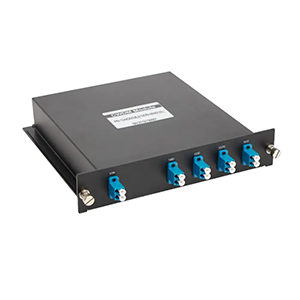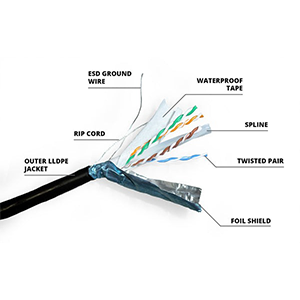Cat6 and Cat6A network cables are widely used in modern networks. This article will explore the feasibility of using Cat6 network cables on Cat6A patch panels. We will first review the technical specifications and main features of Cat6 and Cat6A network cables and compare the differences between the two.
Next, we will explain the application scenarios and key technical indicators of Cat6A patch panels. Then, we will analyze the performance of using Cat6 network cables on Cat6A patch panels and point out its potential limitations and risks. Finally, we will summarize the problems that may be caused by using incompatible cables and provide a reference for users to choose the right network cables.
Differences between Cat6 and Cat6A network cables
The main difference between Cat6 and Cat6A network cables is bandwidth and transmission rate. Cat6 network cables support a maximum bandwidth of 250MHz and a transmission rate of up to 1Gbps, which is suitable for general applications.
Cat6A network cables support a higher bandwidth of 500MHz and a transmission rate of up to 10Gbps, which is suitable for environments with high bandwidth requirements. Cat6A also has better anti-interference ability and is suitable for long-distance transmission.
1. Technical specifications of Cat6 and Cat6A network cables:
- Cat6A supports 10Gbps:
- Cat6A network cables can support Ethernet transmission rates up to 10Gbps.
- Cat6 supports 10Gbps only in short distances:
- Cat6 network cables also support 10Gbps in theory, but only in shorter distances.
- Cat6A has stronger anti-interference and cross-talk capabilities:
- Cat6A network cables have better anti-interference and cross-talk performance.
2. Comparison of the main features of the two types of network cables:
- Cat6A is more suitable for high-speed Gigabit networks:
- Cat6A network cables can fully support 10Gbps high-speed Ethernet applications.
- It has more advantages in scenarios that require long-distance high-speed transmission.
- Cat6 is more economical:
- Cat6 network cables are cheaper than Cat6A.
- For ordinary network scenarios that only require 1Gbps transmission, Cat6 network cables are more cost-effective.
In summary, Cat6A network cables are more suitable for the construction of future high-bandwidth networks due to their better technical indicators, such as support for 10Gbps and stronger anti-interference capabilities. Cat6 network cables have more advantages in price and general application scenarios. Network administrators should choose the appropriate type of network cable according to actual needs.
Characteristics of Cat6A patch panels
Cat6A patch panels support bandwidths up to 500MHz and transmission rates of 10Gbps, suitable for high-speed network environments. It has enhanced anti-interference performance, reduces crosstalk and signal attenuation. The design usually has better shielding and higher wiring density, which is easy to manage and maintain, and is suitable for data centers and high-demand network wiring.
1. Application scenarios and design goals of Cat6A patch panels:
- Provide high-performance connections for 10GbE networks:
- Cat6A patch panels are designed to support 10Gbps Ethernet transmission.
- Meet future high-bandwidth network requirements:
- As network bandwidth requirements continue to increase, Cat6A patch panels can meet the high-speed transmission requirements of future networks.
2. Key technical indicators of Cat6A patch panels:
- Wide bandwidth support:
- Cat6A patch panels support frequency band transmission up to 500MHz.
- Low signal interference:
- Advanced shielding technology can minimize signal interference.
- High-end interface:
- Cat6A patch panel is equipped with high-quality interface to ensure transmission quality.
In general, Cat6A patch panel is a high-performance patch panel system designed to meet future high-bandwidth network applications. It has the characteristics of wide bandwidth support, low signal interference, high-end interface, etc., and can provide reliable connection support for 10GbE and other high-speed networks.
When deploying a high-speed network, choosing a high-quality patch panel that meets the Cat6A standard is crucial to ensure network performance and reliability. This will not only improve the current network experience, but also prepare for future network upgrades.
Feasibility of using Cat6 network cable on Cat6A patch panel
It is feasible to use Cat6 network cable on Cat6A patch panel because Cat6A is backward compatible with Cat6 standard. However, when using Cat6 network cable, the high bandwidth and 10Gbps transmission capacity of Cat6A patch panel cannot be fully utilized. For best performance, it is recommended to use Cat6A network cable that matches the patch panel.
1. Performance of Cat6 network cable on Cat6A patch panel:
- Can work normally:
- Since Cat6A patch panel is backward compatible with Cat6 network cable, it can be used normally.
- But the performance of Cat6A cannot be fully utilized:
- The performance indicators of Cat6 network cables cannot fully meet the technical requirements of Cat6A patch panels.
- Therefore, the high-speed transmission and anti-interference advantages of Cat6A patch panels cannot be fully utilized.
- The transmission rate may be limited and the interference may also increase:
- Using Cat6 network cables may limit the maximum transmission rate of the network.
- It may also increase the risk of signal interference.
2. Potential risks of using incompatible cables:
- Limiting the overall performance and reliability of the network:
- Mismatched cables will reduce the overall performance and reliability of the network.
- May not meet future high bandwidth requirements:
- As network demand continues to grow, Cat6 network cables may not meet future high bandwidth requirements.
In summary, although it is feasible to use Cat6 network cables on Cat6A patch panels, it is not the best choice. In order to give full play to the advantages of Cat6A patch panels and ensure that the network can meet future high-speed transmission needs, it is recommended to use fully compatible Cat6A network cables when deploying. This ensures high performance and reliability of the network.
Summary
Choosing the right network cable and patch panel is the key to ensuring the performance of the enterprise network. Our company has long focused on the research and development and application of network infrastructure products and has rich practical experience. We provide a full range of Cat6 and Cat6A Ethernet cables and patch panels to meet the needs of different network scenarios.
Our products adopt the industry-leading manufacturing process and have achieved excellent levels in transmission performance, anti-interference and reliability. At the same time, our engineering team will provide you with professional demand analysis and solution design services to ensure that the deployed network cable and patch panel solutions can meet your actual needs to the greatest extent. Contact us now to learn more.
Cat6a patch panel and Cat6 cable FAQ
Yes, Cat6 cables can be used with Cat6a patch panels as they are compatible.
Cat6 cables support up to 1 Gbps speeds over 100 meters, while Cat6a supports up to 10 Gbps over 100 meters.
Using a Cat6 cable may limit the overall performance to Cat6 specifications, rather than taking full advantage of Cat6a capabilities.
Yes, the maximum length for Cat6 cables is 100 meters for optimal performance.
Yes, you can mix Cat6 and Cat6a cables, but the overall network performance will be limited to the lowest category used.
While standard RJ45 connectors can be used, it is recommended to use connectors designed for Cat6a to ensure optimal performance.
Cat6a offers better shielding, reduced crosstalk, and the ability to support higher data rates over longer distances.
No, patch panels are generally backward compatible, allowing you to use lower category cables with higher category panels.
Yes, upgrading is straightforward; you can replace the cables and ensure that all network components support the higher category.
Consider your network requirements, such as speed, distance, and future scalability needs, to determine which category is best for you.



